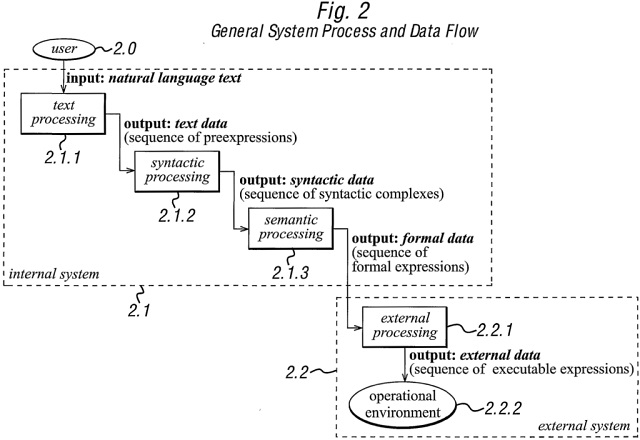Germany: Translation Of A Natural Language Into An Abstract Language: Non-Technical
To print this article, all you need is to be registered or login on Mondaq.com.
This decision concerns a European patent application relating to the translation of a human language into an abstract formal language which was considered non-technical by the EPO's Board of Appeal in charge. Here are the practical takeaways from the decision T 2825/19 (Natural language to machine language translator/RAVENFLOW) of 19.3.2021 of the Technical Board of Appeal 3.5.07:
Key takeaways
The invention
The application underlying the present decision relates to a system and method for translating a natural (human) language into a formal language. The purpose of the formal language is to serve as a template for further translations into a variety of machine languages which are executable in specific operational environments (WO 02/103555 A2, page 1, first paragraph).
More specifically, the invention translates natural language input into internal formal language expressions and then further translates these expressions into executable formal expressions in a formal language such as SQL (structured query language) or SMTPL (the language of the mail protocol SMTP) (WO 02/103555 A2, page 34, last paragraph).

Fig. 2 of WO 02/103555 A2
Here is how the invention was defined in claim 1:
Claim 1 (main request)
A computer-implemented method for translating natural language into a formal language executable on a programmable device, said method comprising the steps of:
- receiving (3.1.1) natural language text;
characterised by:
- parsing (3.1.2) said text into a sequence of sequences of pretokens;
- recognizing (3.2.0) the pretokens as tokens in a lexicon of terms;
- inserting new terms into the lexicon under specific control;
- assigning syntactic types to pretokens by comparison to lexical terms in the lexicon for further syntactic processing;
- generating a sequence of expressions by reassigning lexical types to tokens based on syntactic context based on the assigned types;
- correlating terms occurring in the set of expressions in order to replace indirect references by direct references;
- performing a process of term reduction, using a type reduction matrix, to establish syntactic dependencies between terms in an expression created by said correlating of terms, wherein the type reduction matrix maps sequences of tokens into a relative reduction ordering that represents syntactic dependencies between tokens;
- constructing in a process of term inversion chains of syntactic dependencies among lexical terms in an expression provided by the term reduction process and determining dependencies;
- generating (3.2.3) syntactic trees which represent the syntactic structures of said processed expressions provided by the term reduction process;
- representing said processed expressions as terms in a syntactic algebra on the basis of the syntactic trees, the syntactic algebra comprising syntactic terms formally representing processed expressions;
- representing terms in the syntactic algebra as objects in a semantic algebra, the semantic object algebra comprising semantic objects as internal references of terms in the syntactic algebra;
- combining objects in a semantic object algebra by means of a semantic product on pairs of semantic objects to form more complex semantic objects;
- representing (3.3.1) correlated syntactic algebraic terms and semantic objects as terms in a semantic tensor algebra, the semantic tensor algebra comprising correlated syntactic terms and semantic objects;
- representing terms in the semantic tensor algebra as internal formal models;
- transforming terms in the syntactic algebra into equivalent expressions in an internal formal language;
- associating external operation environments with internal formal models; and
- translating expressions of the internal formal language into equivalent formal expressions executable in an external operational environment.
Is it patentable?
In the first instance, the application underlying the present decision was refused due to lack of inventive step. According to the Examining Division, claim 1 comprises technical and non-technical features. However, in view of the cited prior art, the only identifiable technical contribution consisted in the claimed implementation of the non-technical features in the system disclosed in in cited prior art. More specifically, the Examining Division argued that the translation of linguistic considerations by means of a computer involves technical considerations, but no "further technical considerations" as required by the EPO's case law:
3. (...) According to the examining division (see communication of 13 November 2018, point 4), referring to decisions T 598/14 and T 1177/97, the translation of linguistic considerations into a mathematical model with the aim of enabling the linguistic analysis to be done automatically by a computer could be seen as involving, at least implicitly, technical considerations. However, according to opinion G 3/08 (OJ EPO 2011, 10), point 13.5 of the Reasons, this was not enough as the technical character would have to be established on the basis that those considerations constituted "further technical considerations". Moreover, machine-executable instructions per se were not technical as computer programs as such were explicitly excluded from patentability (Article 52(2)(c) EPC).
Against this assessment, the Appellant inter alia argued as follows:
4. (...) Furthermore, the appellant argued that linguistics was not concerned with translating expressions in an internal formal language into equivalent formal expressions executable in an external operational environment. Rather, steps b) to r) of the claimed method defined a technically advantageous method of translating natural language to executable formal expressions via an abstract formal language. This abstract formal language was explicitly designed to serve as a universal template for further translations into a comprehensive variety of machine languages which were executable in specific operational environments. This was evidence that the steps involved further technical considerations. The method of claim 5 did not use the computer merely as a tool for implementation but focused on improving the computer functionality itself.
However, the Board in charge did not follow the Appellant's arguments:
5.3.6 (...) By contrast, the board sees no support for the appellant's view that the concept "further technical considerations" should be interpreted with a broader meaning that would also cover considerations aiming to solve problems "merely" relating to programming such as maintainability, re-usability and understandability of program code, or, in this case, the use of a universal template for translating natural language into executable expressions in external operational environments. Such a broader view of the concept "further technical considerations" appears to be problematic with regard to the imperative to ensure legal certainty and judicial predictability requiring a uniform application of the law (see opinion G 3/08, Reasons 7.2.3) since no criteria are apparent which could then be used to establish a clear border between "technical" and "non-technical" aspects of computer programs.
5.3.7 In view of the above, the board agrees with the examining division that steps b) to p) do not contribute to the technical character of the claimed invention as these steps do not involve technical considerations going beyond "merely" finding an abstract computer algorithm to carry out the translation from natural language text into an internal formal language.
As a result, the appeal was dismissed.
The content of this article is intended to provide a general guide to the subject matter. Specialist advice should be sought about your specific circumstances.
POPULAR ARTICLES ON: Intellectual Property from Germany

No comments:
Post a Comment